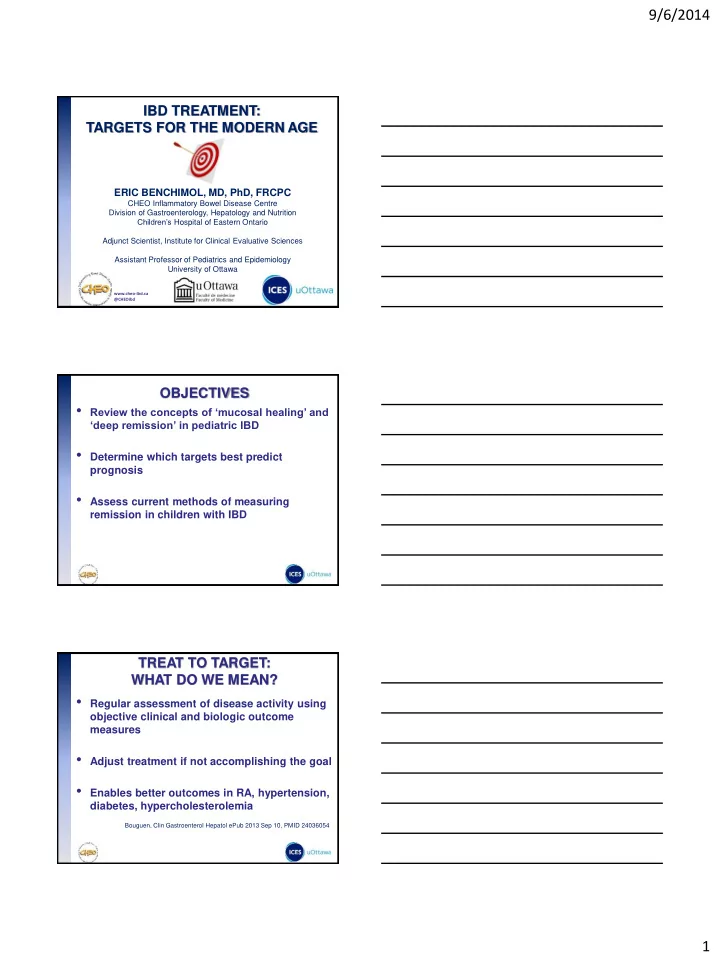

9/6/2014 IBD TREATMENT: TARGETS FOR THE MODERN AGE ERIC BENCHIMOL, MD, PhD, FRCPC CHEO Inflammatory Bowel Disease Centre Division of Gastroenterology, Hepatology and Nutrition Children’s Hospital of Eastern Ontario Adjunct Scientist, Institute for Clinical Evaluative Sciences Assistant Professor of Pediatrics and Epidemiology University of Ottawa www.cheo-ibd.ca @CHEOibd OBJECTIVES • Review the concepts of ‘mucosal healing’ and ‘deep remission’ in pediatric IBD • Determine which targets best predict prognosis • Assess current methods of measuring remission in children with IBD TREAT TO TARGET: WHAT DO WE MEAN? • Regular assessment of disease activity using objective clinical and biologic outcome measures • Adjust treatment if not accomplishing the goal • Enables better outcomes in RA, hypertension, diabetes, hypercholesterolemia Bouguen, Clin Gastroenterol Hepatol ePub 2013 Sep 10, PMID 24036054 1
9/6/2014 TREAT TO TARGET: WHAT DO WE MEAN? Control of Predefined timeframe intestinal inflammation Assessment Assessment Baseline Assessment High Avoidance of long-term progression Continue therapy, Therapy according bowel Risk of to risk and target target surveillance damage and disability Target Low Unreached Target Bouguen, Clin Gastroenterol Hepatol ePub 2013 Sep 10, PMID 24036054 WHAT WERE THE OLD TARGETS? GOALS OF TREATMENT • “Clinical Remission” • “Feeling better” • Short Term: Crohn’s: No pain, no diarrhea UC: No urgency, no bleeding Normal growth and development Nutrition Improved laboratory markers 2
9/6/2014 PEDIATRIC TRIALS • 6MP/Prednisone Trial: Primary: Harvey-Bradshaw Index Secondary: Corticosteroid use, growth, AEs, surgery Markowitz, Gastroenterol 2000;119:895-902 • Budesonide in Crohn’s: Primary: CDAI Secondary: PCDAI, AEs, cortisol Escher, Eur J Gastroenteorl Hepatol 2004;16:47-54 • REACH: Primary: PCDAI Secondary: QoL (IMPACT), steroid use, growth, ADAs, AEs Hyams, Gastroenterol 2007;132:863-73 WHY NOT USE DISEASE SCORES? • Active disease ≠ abnormal laboratory markers Mack, Pediatrics 2007;119:1113-9. • Active symptoms ≠ active disease Vivinus-Nébot, Gut 2014;63(5): 744-52. Relationship Between Clinical Symptoms and Endoscopic Indices at Presentation of Acute CD 600 Crohn’s Disease Activity Index 500 400 ( CDAI ) 300 200 100 R=0.13; NS 0 0 5 10 15 20 25 30 35 Crohn’s Disease Endoscopic Index of Severity (CDEIS) Modigliani, Gastroenterology 1990;98:811 Slide courtesy of Dr. David Rubin 3
9/6/2014 WHY NOT USE DISEASE SCORES? • Active disease ≠ abnormal laboratory markers Mack, Pediatrics 2007;119:1113-9. • Active symptoms ≠ active disease Vivinus-Nébot, Gut 2014;63(5): 744-52. • No clear evidence of correlation between DAIs, symptoms, labs, and mucosal disease (Except PUCAI) Turner, Gastroenterol 2007;133:423-32. WHICH TARGETS SHOULD WE USE? • High correlation with outcomes Flares Surgery Hospitalization Complications • Measurement is achievable, feasible • Cost effective • Relevant to patients PROs WHAT ARE THE NEW TARGETS? 4
9/6/2014 MUCOSAL HEALING – CROHN’S • Post-hoc/secondary analyses of RCTs Accent-I ( Rutgeerts, Gastroenterol 2004;126:402-13) EXTEND (Rutgeerts, Gastroenterol 2012;142:1102-11) Step-Up/Top-Down (Baert, Gastroenterol 2010;138:463-68) • Retrospective Cohort Studies IBSEN (Frøslie, Gastroenterol 2007;133:412-22) Leuven Infliximab Cohort (Schnitzler, Inflamm Bowel Dis 2009;15:1295-1301) MUCOSAL HEALING – UC Mucosal healing at 3 months after first course of steroids is associated with favorable prognosis Group A: Clinical and endoscopic remission (Powell-Tuck, 0 – 1; Baron Score, Survival distribution function for 0) treatment and/or colectomy hospitalizations and/or immunosuppressive Group B: Clinical but no endoscopic remission (Powell-Tuck, 0 – 1; Baron, 1 – 3 Ardizzone, Clin Gastroenterol Hepatol 2011;9:483 – 9 Slide courtesy of Dr. David Rubin 5
9/6/2014 Mucosal Healing at Year 1 Associated with Risk of Subsequent Colectomy in Ulcerative Colitis P <0.05 Frøslie, Gastroenterology 2007;133:412-422. CONCLUSION: There is ample retrospective evidence that MH is associated with improved long- term outcomes but… IS THIS ACHIEVABLE? IS MUCOSAL HEALING ACHIEVABLE? • Likelihood of mucosal healing: Bouguen, Clin Gastroenterol Hepatol 2014;12:978-85. 6
9/6/2014 IS MUCOSAL HEALING ACHIEVABLE? • Predictors of mucosal healing: HR 2.35 (95%CI 1.15-4.97) HR 4.28 (95%CI 1.9-11.5) Bouguen, Clin Gastroenterol Hepatol 2014;12:978-85. CONCLUSION: MH is achievable, with aggressive monitoring and management but… SURROGATE MARKERS? IMAGING • Prospective study, segmental analysis Kappa 0.73-0.76 Moreno, J Crohn Colitis 2014;8:1079-87. • MR Enterography, CDEIS vs. MaRIA scores Ulcer healing: 90% accuracy Endoscopic remission: 83% accuracy Ordás, Gastroenterology 2014;146:374-82. 7
9/6/2014 SURROGATE MARKERS • Prospective: Fecal Calprotectin associated with MH in UC (AUROC 0.754) Guardiola, Clin Gastroenterol Hepatol ePub 2014 Jun 30, PMID 24993368 • BUT calprotectin not as accurate in children Sensitivity 97.8%, specificity 68.2% Henderson, Am J Gastroenterol 2014;109:637-45. SURROGATE MARKERS - CRP • “Silent” Crohn’s patients have no symptoms • But majority have an elevated CRP • Higher risk of hospitalization Obstruction Surgery Vargas, Gastrenterology 2013;144(5):S102 (DDW Abstract 557). SURROGATE MARKERS - CRP • BUT… Tsampalieros, J Pediatr 2011;159:340-2. • In UC, ESR+CRP may be valuable Turner, J Crohns Colitis 2011;5:423-9. 8
9/6/2014 SURROGATE MARKERS - PUCAI • At 3 months: Schechter, Gut ePub 2014 May 21, PMID 24848266 Area Under the ROC: 0.75 (95%CI 0.60-0.89) PUCAI>10: Sens 90%, NPV 91% for SSFR For colectomy: Sens 82%, Spec 64% SURROGATE MARKERS • ACT-I and ACT-II: Serum infliximab trough levels associated with MH Adedokun, Gastroenterology ePub 2014 Aug 27, PMID 25173754 SURROGATE MARKERS • ACT-I and ACT-II: Serum infliximab trough levels associated with MH Adedokun, Gastroenterology ePub 2014 Aug 27, PMID 25173754 • Adalimumab level <4.9 predictive of absence of MH Sens 66%, Spec 85%, PPV 88%, NPV 51%, LR 4.3 Roblin, Clin Gastroenterol Hepatol 2014;12:80-84 9
9/6/2014 SUMMARY • What is the optimal target? NEEDS Prospective validation Mucosal healing by Optimal intervals endoscopy Pediatric studies Association with outcomes Imaging (MRE, Pediatric studies capsule) Surrogate markers More accurate markers (ESR/CRP, fecal Validation vs. endoscopy biomarkers) Validation vs. endoscopy Optimized disease Association with outcomes activity scores WHAT ABOUT THERAPY DE-ESCALATION? SUGGESTED ALGORITHM Bouguen, Clin Gastroenterol Hepatol ePub 2013 Sep 10, PMID 24036054 CONCLUSIONS • Ample evidence mucosal healing improves long-term outcomes • Retrospective, observational, post-hoc analyses • Requires aggressive endoscopy, changes in treatment • Unanswered questions • RCTs • Histologic inflammation • Surrogate markers • De-escalation • Risk, Cost-benefit • Pediatric data • Patient preference 10
Recommend
More recommend